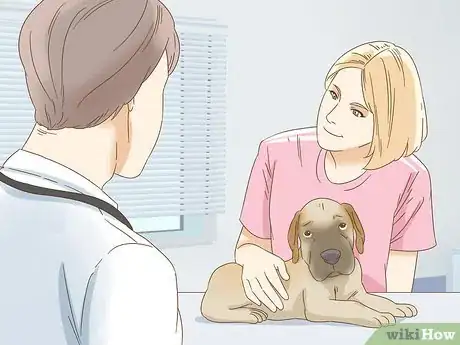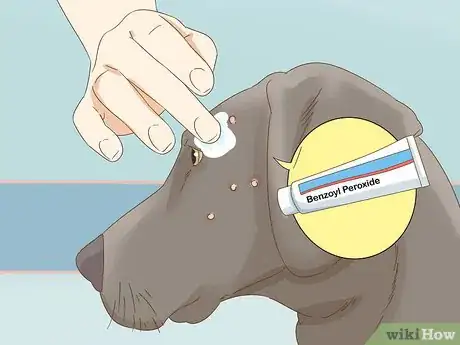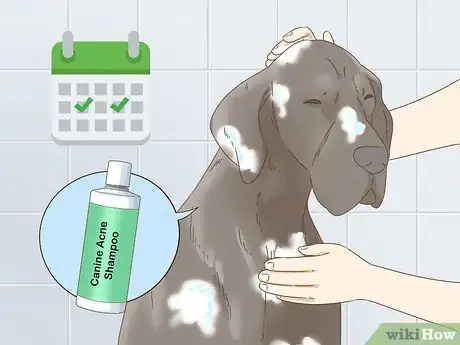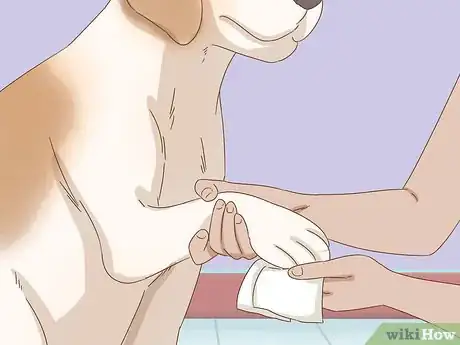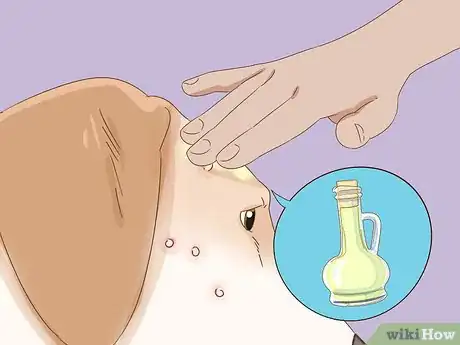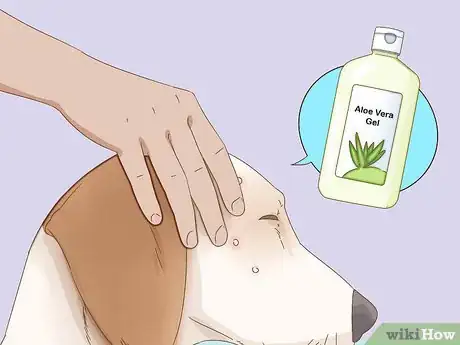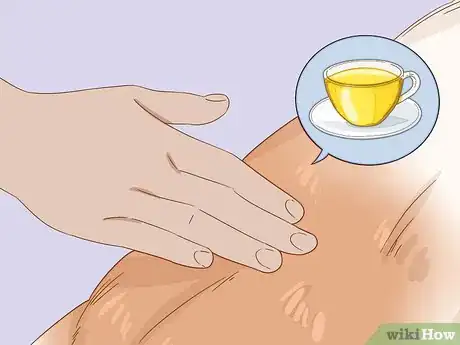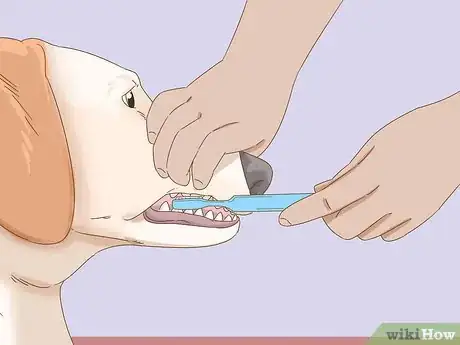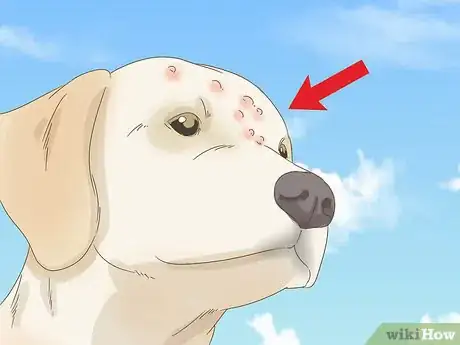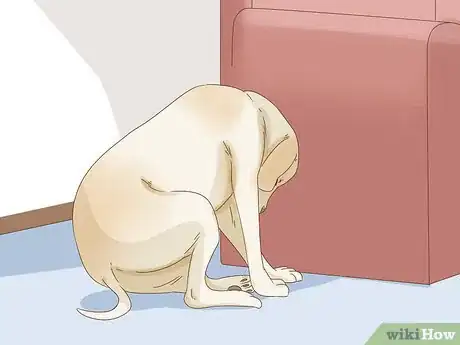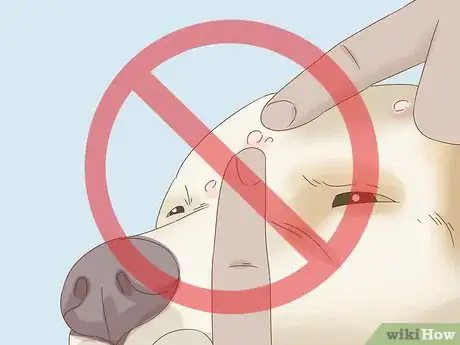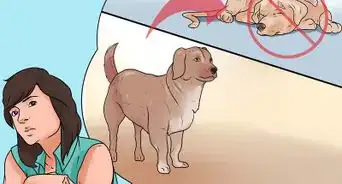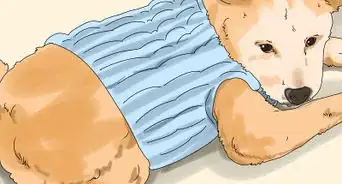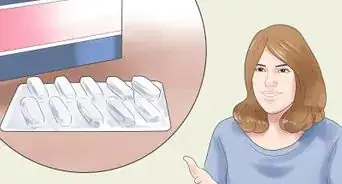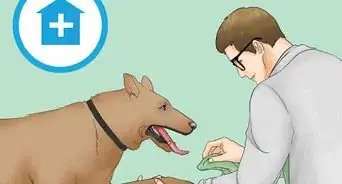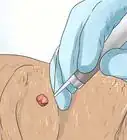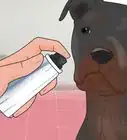This article was co-authored by Pippa Elliott, MRCVS. Dr. Elliott, BVMS, MRCVS is a veterinarian with over 30 years of experience in veterinary surgery and companion animal practice. She graduated from the University of Glasgow in 1987 with a degree in veterinary medicine and surgery. She has worked at the same animal clinic in her hometown for over 20 years.
This article has been viewed 44,551 times.
Canine acne is a skin condition that mainly affects young dogs, especially puppies that are 1 year old or younger. This genetic and hormonal conditional is particularly prevalent in Boxers, Great Danes, Dobermans, Bulldogs, and Bull Terriers, and though it can make your puppy uncomfortable, it's easily treated. If this is your first time dealing with canine acne, take your pup to a vet to confirm the diagnosis. Then, follow the vet's treatment advice to clear up the acne within a few months, or try using natural solutions.
Steps
Using Medication
-
1Take your dog to the vet for a professional diagnosis. It is important to take your dog to the vet to rule out other uncommon but serious skin conditions such as demodicosis, ringworm, and puppy strangles. Show the vet your dog’s symptoms and tell them when they first appeared. Ask your vet to explain the different treatment options and to prescribe your dog any necessary medications.[1]
- Vet appointments usually start at around $50. Call your local vet to get a quote for your appointment.
- Vets will often take a strand of hair or skin scrape from your dog to check for demodectic mange mites.
- Canine acne is a common and treatable condition, and you will usually only need to visit the vet once to treat it.
-
2Apply a benzoyl peroxide or antibiotic gel to your dog's skin to reduce inflammation. Apply a thin coating to the affected area each day, or as prescribed by the vet. If your dog has recurring acne, ask the vet for a long-term prescription of antibiotics or benzoyl peroxide gel to keep the acne under control.[2]
- Do not use products designed to treat human acne, because the percentage of benzoyl peroxide will likely be much higher and may irritate your dog's skin.
Advertisement -
3Give your dog oral antibiotics for severe cases of canine acne. If your vet thinks the acne is severe, they may prescribe oral antibiotics as opposed to an antibiotic cream. Give your dog 1 tablet twice daily, or as prescribed by the vet. If you have difficulty getting your dog to swallow the pills, try hiding the medicine in your pup's food.[3]
- Make sure to finish the entire dose of antibiotics, otherwise, the treatment may not be successful.
-
4Use a canine acne shampoo twice a week to keep your dog’s skin clean. Canine acne shampoos contain a small amount of benzoyl peroxide, which helps get rid of the acne-causing bacteria and reduces further acne outbreaks. To apply, wet your dog's face with water and then use an old flannel to gently apply the shampoo to the affected area. Use a clean damp flannel to wipe the shampoo residue off your dog.[4]
- Follow the vet's dosage instructions to avoid drying out your dog's skin.
- Dry your dog with an old towel after you have used the shampoo, as the benzoyl peroxide will bleach your towels.
- Most veterinary prescribed shampoos contain around 3% benzoyl peroxide. Avoid using a shampoo that contains more than 5% benzoyl peroxide, as this can dry out your dog's skin.
-
5Spread a thin layer of steroid cream over your dog’s skin if the vet prescribes it. Steroid cream tends to be a prescription-only cream, as over-use can damage your dog's skin. Apply the steroid cream with a gloved hand to avoid touching the gel.[5]
- Follow the dosage and application instructions given by your vet.
- Disposable latex gloves work well for applying the cream.
Trying Natural Treatments for Canine Acne
-
1Keep your dog’s skin clean. Acne is the result of a buildup of oils and dirt on your dog’s skin, so the best natural treatment you can use is to clean your dog’s skin. Wipe your dog’s skin twice daily with diluted chlorhexidine to remove dirt and oils. Then, pat your dog’s skin dry after you finish wiping it off.
- Be aware that other natural treatments are unproven, so you may want to start by cleansing your dog’s skin twice daily and see if that helps first.
-
2Apply coconut oil to the affected area once a day if the acne is mild. Coconut oil has antibacterial and antifungal properties that are useful for treating canine acne. This treatment is best used for mild acne in conjunction with other treatment plans. Thinly spread coconut oil over the acne to help reduce the number of bacteria on your dog’s skin.[6]
- Use a cold-pressed organic coconut oil for best results.
- If the acne persists after using the coconut oil, seek further advice from a vet. You may have misdiagnosed your pup, or you may need to try a stronger medication.
- Be aware that adding any oils to the skin may also clog your dog’s pores and make the problem worse.
-
3Spread aloe vera gel over the affected area to soothe your dog’s skin. Aloe vera has great antibacterial and astringent properties, which help cool your dog's skin and minimize the amount of bacteria in the area. Apply the aloe vera gel twice a day to clean skin.[7]
- Wash your dog’s face before you apply the gel.
- Purchase dog-specific aloe vera gel from a vet.
-
4Apply green tea to your dog’s skin to reduce itching. Brew a batch of green tea and wait for it to cool, then wipe the tea over the affected area to reduce infection and decrease the itching sensation. Apply the tea as often as required to help soothe the skin and reduce the itching.[8]
- Use organic green tea to reap the greatest benefits. Purchase green tea from a supermarket or health food store.
-
5Brush your dog's teeth daily to remove bacteria. Though brushing your pup's teeth won't directly treat canine acne, bacteria from your dog’s teeth can be passed into its saliva and then be spread around the dog’s face when it drools or licks itself. Clean your dog’s teeth to remove the build-up of bacteria and to prevent the bacteria from entering any wounds associated with the acne.[9]
- If your dog won’t let you brush its teeth, give it an edible dental treat instead. You can purchase these from a vet or some specialty pet stores.
Identifying Canine Acne
-
1Check for red bumps and blackheads. Look for any signs of swelling, redness, pus, scabs, and scarring. These tend to be most heavily located on your pup's face. If your dog has any of these symptoms, it may have canine acne.[10]
- If the spots become infected, the lumps may burst and exude a sticky discharge called "seropurulent". This is straw-coloured and slightly tacky to the touch, and may be accompanied with pus.
- If your dog is visibly in pain, arrange a vet appointment as soon as possible.
-
2Watch for unusual behaviour and visible signs of pain. Note whether your dog is rubbing its face on furniture more than usual, as this can be a sign that the acne is irritating your dog. If your dog is groaning or howling more than usual, this may signify that it is in pain.
- Take a note of the unusual behaviour so that you can tell the vet how long it has been occurring for.
-
3Avoid squeezing any pimples on your dog before you go to the vet. Though it can be tempting to squeeze pimples, you may rupture your pup's hair follicles and cause further inflammation. Popping the pimples will also make it harder for the vet to diagnose the infection.[11]
- Even if the lesions on your dog look painful, don’t touch them or squeeze them.
References
- ↑ https://www.petmd.com/dog/conditions/skin/c_dg_acne?page=show
- ↑ https://vcahospitals.com/know-your-pet/acne-in-dogs
- ↑ https://www.petmd.com/dog/conditions/skin/c_dg_acne?page=show
- ↑ https://www.petmd.com/dog/conditions/skin/c_dg_acne?page=show
- ↑ https://www.petmd.com/dog/conditions/skin/c_dg_acne?page=show
- ↑ https://www.whole-dog-journal.com/issues/8_10/features/How-Coconut-Oil-Benefits-Dogs_15754-1.html
- ↑ https://www.natural-dog-health-remedies.com/canine-acne.html
- ↑ https://www.natural-dog-health-remedies.com/canine-acne.html
- ↑ https://www.cesarsway.com/dog-care/skin-care/solutions-for-your-dogs-acne
About This Article
Canine acne can make your dog uncomfortable, but luckily, it’s easily treated. Once your vet diagnoses canine acne, treat the bumps with a thin coat of benzoyl peroxide or antibiotic gel each day. If the acne is severe, your vet may prescribe oral antibiotics, which you’ll have to administer to your dog each day. Twice a week, wash your dog with a canine acne shampoo to help clear up and prevent breakouts. Read on for tips from our Veterinary co-author on how natural treatments may help with canine acne!
